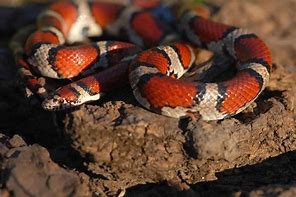Milk Snakes: Facts and How They Earned Their Name
Milk snakes, or Lampropeltis Triangulum, get their name from an old folktale that depicts these snakes sucking cow udders to get milk. While the myth is false, since milk snakes do not have the physical ability to do so, milk snakes are often found in or around barns, due to their cool and dark environment, which is what most likely resulted in the folktale.
Milk snakes are a non-venomous species of kingsnake, have a lifespan of 12 to 21 years, and a length of 60 to 132 centimeters, or 24 to 52 inches. The largest milk snakes are typically found in Central and South America. They live in forested regions, tropical hardwood forests, open woodland, open prairies, grasslands, shrublands, and can also be found in small streams, marshes, and rocky slopes. They live in tropical and temperate climate zones and typically live on the ground but will occasionally climb trees to eat birds and their eggs. Milk snakes are nocturnal hunters, meaning that they are active at night and hide during the day. Young snakes usually eat slugs, insects, crickets, and earthworms while adult snakes eat lizards, small mammals, frogs, fish, and even other snakes.
Between the 24 subspecies of milk snakes, there is a great amount of variation in appearance and color. One physical attribute that all milk snakes share are the bands on their bodies. These bands help keep predators away however they also cause humans to mistake milk snakes as coral snakes, causing humans to attack and kill the milk snakes. All species of milk snakes are absolutely harmless and pose no threat to humans.
These snakes mostly live in solidarity and only come together to mate and during hibernation. During the latter, milk snakes will come together in groups and hibernate in communal dens to share body heat and effectively regulate their body temperature. Similar to hibernation, the snakes then enter brumation which is like hibernation, but the animal will wake up to drink water and return to “sleep”. During the breeding season, which is from early May to late June, male and female snakes will mate with multiple snakes, also known as a polygynandrous mating system. In June and July, the female snake will lay from 3 to 24 eggs and then leave. The eggs enter a 2-month long incubation period and then hatch around August or September. As soon as they are born the hatchlings are independent and ready to fend for themselves. Fun Fact: A baby snake is called a snakelet.


.jpg)
Comments
Post a Comment